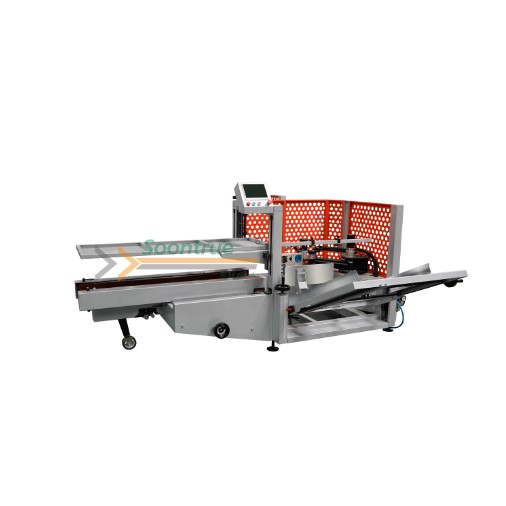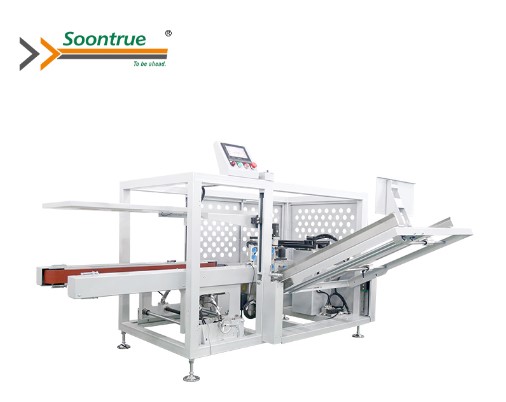Case Former Vs Case Erector: What Is The Difference?
Case formers and case erectors are both important machines used in the packaging industry, but they serve different purposes in the box-making process. Understanding the distinctions between these two machines is critical for improving your packaging processes and producing high-quality boxes efficiently.
Case Former
A case forming is a machine used to assemble and glue the bottom flaps of a corrugated box or carton. It takes a flat, die-cut blank and folds it into a box form, using glue to seal the bottom flaps. The case former can be manual or automatic, depending on the production volume and level of automation in the packaging line.
The main components of a case former include:
Blank magazine: Holds the flat, die-cut blanks and feeds them into the machine one at a time.
Folding mechanism: Folds the blank into a box shape, creating the bottom, sides, and top flaps.
Gluing system: Applies adhesive to the bottom flaps, ensuring a secure seal.
Compression section: Applies pressure to the glued flaps to ensure a strong bond.
Case formers are designed to handle a variety of box sizes and styles, making them versatile machines in the packaging industry. They are commonly used in industries such as food and beverage, consumer goods, and e-commerce, where large quantities of boxes are required for product packaging and shipping.Case Erector
A case erector, on the other hand, is a machine used to build and glue the top flaps of a corrugated box or carton. It takes a pre-formed box, sometimes known as a "blank," and turns it into a completely formed box by applying glue to the top flaps to keep them in place. Case erectors can be manual, semi-automatic, or fully automatic, depending on the production requirements and level of automation in the packaging line.
The main components of a case erector include:
Box magazine: Holds the pre-formed boxes and feeds them into the machine one at a time.
Erecting mechanism: Expands the pre-formed box into a fully formed box shape.
Gluing system: Applies adhesive to the top flaps, ensuring a secure seal.
Compression section: Applies pressure to the glued flaps to ensure a strong bond.
Case erectors are designed to handle a variety of box sizes and styles, just like case formers. They are commonly used in industries such as food and beverage, consumer goods, and e-commerce, where large quantities of pre-formed boxes are required for product packaging and shipping.

Key Differences
The main differences between case formers and case erectors are:
Function: Case formers assemble and glue the bottom flaps of a corrugated box or carton, whereas case erectors construct and attach the top flaps of a prefabricated box.
Timing in the packaging process: Case formers are typically used earlier in the packaging process, as they create the box shape from a flat blank. Case erectors are employed later in the process to combine pre-formed boxes into their final shape and seal the upper flaps.
Input material: Case formers use flat, die-cut blanks as their input material, while case erectors use pre-formed boxes.
Output: Case formers output partially formed boxes with the bottom flaps glued, while case erectors output fully formed boxes with the top flaps glued.
Automation level: Both case formers and case erectors can be manual, semi-automatic, or fully automatic, depending on the production requirements and level of automation in the packaging line.
Advantages of Case Formers
Flexibility: Case formers can handle a variety of box sizes and styles, making them versatile machines in the packaging industry.
Space-saving: By forming the boxes from flat blanks, case formers require less storage space for raw materials compared to pre-formed boxes.
Cost-effectiveness: Flat blanks are generally less expensive to produce and transport than pre-formed boxes.
Customization: Case formers allow for easy customization of box designs, as the flat blanks can be printed or die-cut with various patterns and graphics.
Advantages of Case Erectors
Efficiency: Case erectors can assemble and seal pre-formed boxes at high speeds, increasing overall production efficiency.
Consistency: Case erectors provide consistent box assembly and gluing, ensuring a uniform appearance and structural integrity of the final product.
Reduced labor: Automated case erectors can reduce the need for manual labor in the box assembly process, leading to cost savings and improved worker safety.
Versatility: Like case formers, case erectors can handle a variety of box sizes and styles, making them suitable for a wide range of packaging applications.
Conclusion
Case formers and case erectors are both essential machines in the packaging industry, but they serve different purposes in the box-making process. Understanding the distinctions between these two machines is critical for improving your packaging processes and producing high-quality boxes efficiently.



